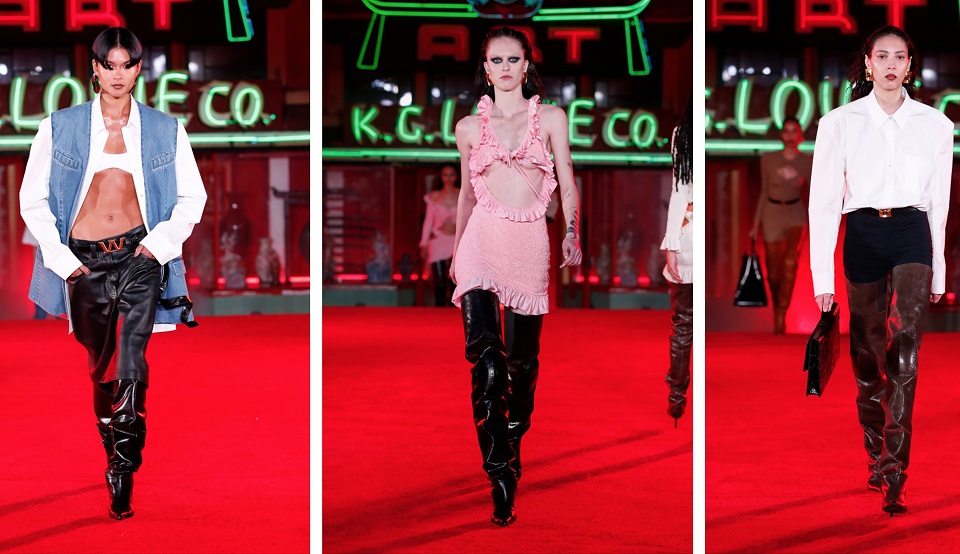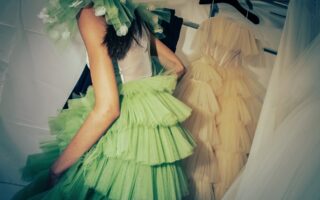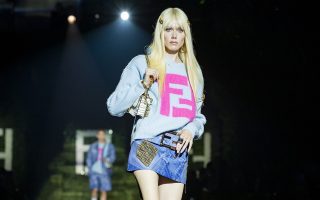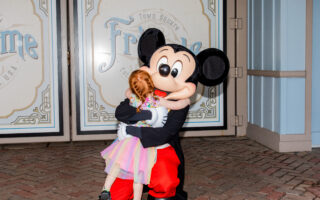Alexander Wang returns to the runway

Dozens of showgoers approached security personnel and black-clad staff with the same question: Would there be an after-party? But the answer, for one of the first times at a major Alexander Wang fashion show, was a resounding no.
It was one of many shifts for a brand that has remained remarkably and, at times, obstinately consistent in the 17 years the label has existed. After a three-year hiatus, Alexander Wang returned to the runways Tuesday night with “Fortune City,” which, the invitation promised, would be “a multilayered event and runway show celebrating Asian American culture, food and music.”
It took place in Chinatown Central Plaza in Los Angeles, before 800 attendees, 500 of whom were members of the public who signed up for a spot via a general admissions link advertised on a billboard in Hollywood and on the label’s social media.
A separate entrance and time to shop the night market was set aside for Wang’s VIP guests, including reporters and editors, and celebrities like designer Kimora Lee Simmons, K-pop star CL and model Behati Prinsloo Levine.
Far from the star-studded front row that used to make up his #WangSquad at previous shows, star in his campaigns and party with him on weekends, this was a small group of friends who could weather the backlash that comes with being seen at an event hosted by a designer whose reputation has suffered since 2021, when sexual misconduct allegations against him became public.
Early last year, 10 men, mostly anonymous and represented by the high-profile victims’ rights lawyer Lisa Bloom, accused Wang of sexual assault during parties. Wang initially called the allegations “baseless and grotesquely false” but later, according to a tweet by Bloom, spoke directly with the accusers. Wang published a public apology on Instagram, and Bloom wrote on Twitter, “We acknowledge Mr. Wang’s apology and we are moving forward.”
“I’m not only supporting Alex as a person and friend, but he’s a hell of a designer,” said Erika Jayne, a singer and star of “The Real Housewives of Beverly Hills,” who is also familiar with being in the spotlight for high-profile accusations. Rapper Maliibu Miitch said she didn’t care about the allegations: “He was there for me when nobody else even cared about my little Bronx self, so I’m going to support him. No matter what, I love Alex. His heart is beautiful.”
On the runway, there were more old friends, including Hanne Gaby Odiele, Soo Joo Park and Adriana Lima, whose pregnant stomach was on display underneath a weblike black top. The clothes, too, were familiar: very much a continuation of the denim, leather and party-frock fare that has always been the foundation of the label.
Hems were short; shoulders were sharp and squared off; and cutout knit tops displayed ample cleavage and more. Crystal bags, tucked under arms and palmed by the models, looked like chandeliers that had been pilfered during a raucous night out. If you weren’t paying attention to the derailments of the past couple of years, it might have seemed like simply business as usual at the label.
But something had indeed happened. Interview requests with Wang were denied. Noticeably absent was any mention of the word “party,” which was once central to Wang’s identity, his creative muse and the marketing superpower of the designer and his business – and what threatens to kneecap a lucrative company.
The collection, instead, seemed to be anchored in his Chinese heritage. Attendees received Alexander Wang-branded vouchers that they were able to spend at the stalls of local Chinese vendors who offered meat skewers, dragon’s beard candy and bingtanghulu (candied hawthorne fruit, reportedly a nostalgic hit with the Chinese models backstage). There were limited-edition T-shirts for sale with all proceeds going to the Los Angeles Chinatown Corp., whose mission is to preserve and increase the value of Central Plaza.
The organization had helped identify suitable vendors, as well as a restoration project for Wang to finance: the dilapidated Wishing Well that sits in the center of Chinatown and that had been pockmarked by aggressive coin throwers testing their luck and aim for the last 85 years. The well, constructed in 1938, was newly painted and refurbished by Wang. (For an idea of how much it could have cost, the Los Angeles Times noted, in 2003, that it would take $20,000 for a full restoration.)
For Bauer Wann, 30, who requested an invitation on social media, the Chinatown aspect was a compelling draw. “If it wasn’t for supporting Chinatown, I would definitely be a lot more hesitant to be here,” he said.
Until recently, Wang’s identity as Chinese American was rarely mentioned. He ignored attempts by reporters and critics to connect his designs with his identity as a child of Taiwanese immigrants, even as he was frequently compared to Asian American peers like Phillip Lim and Prabal Gurung, who have long described their ethnic backgrounds as a relevant to their design choices.
Even so, Wang’s background has been well documented. His parents are first-generation immigrants and ran a successful manufacturing business in San Francisco. His friends, along with his clientele, were “It” girls, models, former boarding-school rich kids and the ethnically diverse, largely queer community of party people who wanted their clothes to express the simple fact that they were out last night.
Wang’s laser focus paid off. Sales reached more than $100 million at one point, according to Business of Fashion.
But the brand began to lose relevance soon afterward. In 2019, Wang attempted a rebrand for the label that included a new logo and a commitment to telling his American story through a first-generation immigrant’s lens, which was inspired by what his parents had only recently told him about what it was like to come to America in the 1970s.
“I had never asked them before,” Wang, who was 35 at the time, told The New York Times in 2018.
But among the Asian American attendees, many chalked up the late-blooming consciousness to more personal reasons: “There was a lot of people in our community that did not want to associate themselves too much with the Asian experience,” said May Lee, 56, who is involved in a variety of local Asian Americans and Pacific Islanders, or AAPI, organizations and attended the event to show support to Asian American designers. “Don’t make noise, don’t make waves, fit in.”
“I don’t want to blame Alexander Wang, but I think he is an example of that type of Asian going through that type of experience,” she continued. “I say better late than never.”
Robert Andre Pei Johnson, 26, said: “It would have been hard to do it previously because people weren’t open to it previously. Different times call for different exceptions. He couldn’t not be standing for it now.”
Johnson’s friend Jonathan Muench, 30, who is half-Chinese, compared it to his own journey. “As I’m getting into my 30s, I’m getting closer to my culture,” he said. “It could be natural for him, too.”
Without the opportunity to speak with Wang, it’s hard to determine if or how the new collections he showed are related to his growing Chinese identity. Wang likely sees mainland China as a vast revenue opportunity, according to Business of Fashion, which reported that the sexual assault allegations have had little impact on his brand perception there and that he has recently met with Chinese investors.
But for more Asian Americans to see Wang as a genuine advocate for and representative of their community, he will need to contend with the sudden about-face as well as the fallout from a $45 million lawsuit filed against him in New York in 2012, in which 30 former employees, mostly Chinese, accused him of operating a sweatshop out of his Chinatown garment factories. The lawsuit was dismissed with prejudice, and neither party disclosed whether there was a financial settlement.
There have been small attempts, at least on social media, to give more context to Wang’s new embrace of his Chinese identity. On the official Alexander Wang Instagram account are calls to action to support AAPI-related causes, including a relief fund for a recent fire that killed two tenants and destroyed several small businesses in Chinatown in New York. It’s unclear how the Wang business is connected with the nonprofit, Welcome to Chinatown, beyond drawing attention to its initiatives.
Privately, Wang seems to be approaching the work in ways that community advocates say is helpful. “We’re really grateful that Alexander Wang has taken the extra steps to work with Chinese merchants through language barriers, payment barriers,” said Shirley Zhang of the Los Angeles Chinatown Business Council, who worked with the fashion company to put on the show. “They work so hard, and the margins are so thin here in Chinatown.”
If Wang’s show seemed at once familiar – the clothes, especially – and newly careful (the lack of a louche after-party), that could be in part because of all that looms over his comeback, including his unusual mandate to market his personal journey in order to move product. He also has little leverage left to make a mistake.
This article originally appeared in The New York Times.






